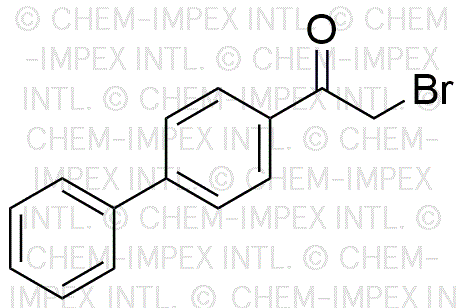2-Bromo-4'-phenylacetophenone is widely utilized in research focused on:
- Organic Synthesis: This compound serves as an important intermediate in the synthesis of various organic molecules, particularly in the development of pharmaceuticals and agrochemicals.
- Photoinitiators: It is commonly used as a photoinitiator in UV-curable coatings and inks, enabling faster curing processes and improved durability in products.
- Polymer Chemistry: The compound plays a significant role in the production of specialty polymers, enhancing properties such as thermal stability and mechanical strength.
- Analytical Chemistry: It is utilized in analytical methods for detecting and quantifying other compounds, providing reliable results in quality control processes.
- Research Applications: In academic and industrial research, it is employed in studies related to photochemistry and materials science, contributing to advancements in these fields.
General Information
Properties
Safety and Regulations
Applications
2-Bromo-4'-phenylacetophenone is widely utilized in research focused on:
- Organic Synthesis: This compound serves as an important intermediate in the synthesis of various organic molecules, particularly in the development of pharmaceuticals and agrochemicals.
- Photoinitiators: It is commonly used as a photoinitiator in UV-curable coatings and inks, enabling faster curing processes and improved durability in products.
- Polymer Chemistry: The compound plays a significant role in the production of specialty polymers, enhancing properties such as thermal stability and mechanical strength.
- Analytical Chemistry: It is utilized in analytical methods for detecting and quantifying other compounds, providing reliable results in quality control processes.
- Research Applications: In academic and industrial research, it is employed in studies related to photochemistry and materials science, contributing to advancements in these fields.
Documents
Safety Data Sheets (SDS)
The SDS provides comprehensive safety information on handling, storage, and disposal of the product.
Product Specification (PS)
The PS provides a comprehensive breakdown of the product’s properties, including chemical composition, physical state, purity, and storage requirements. It also details acceptable quality ranges and the product's intended applications.
Certificates of Analysis (COA)
Search for Certificates of Analysis (COA) by entering the products Lot Number. Lot and Batch Numbers can be found on a product’s label following the words ‘Lot’ or ‘Batch’.
*Catalog Number
*Lot Number
Certificates Of Origin (COO)
This COO confirms the country where the product was manufactured, and also details the materials and components used in it and whether it is derived from natural, synthetic, or other specific sources. This certificate may be required for customs, trade, and regulatory compliance.
*Catalog Number
*Lot Number
Safety Data Sheets (SDS)
The SDS provides comprehensive safety information on handling, storage, and disposal of the product.
DownloadProduct Specification (PS)
The PS provides a comprehensive breakdown of the product’s properties, including chemical composition, physical state, purity, and storage requirements. It also details acceptable quality ranges and the product's intended applications.
DownloadCertificates of Analysis (COA)
Search for Certificates of Analysis (COA) by entering the products Lot Number. Lot and Batch Numbers can be found on a product’s label following the words ‘Lot’ or ‘Batch’.
*Catalog Number
*Lot Number
Certificates Of Origin (COO)
This COO confirms the country where the product was manufactured, and also details the materials and components used in it and whether it is derived from natural, synthetic, or other specific sources. This certificate may be required for customs, trade, and regulatory compliance.


